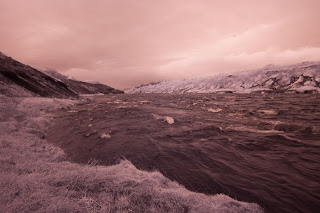OK, before getting to the photography, let's help out the non-British readers with one of the most wonderful spreads you can get: Marmite!
For me, Marmite is best served, thinly spread on warm toast. Marmite is a dark brown-coloured savory spread made from the yeast that is a
by-product of the brewing industry. It has a very strong, slightly
salty flavor. It is definitely a love-it-or-hate-it type of food. Hence the 'Marmite view' reference above.
For the 100th anniversary of Marmite in 2002, thirty-three London taxis
were painted to feature the slogan, '100 years of HATE' on one side and
'100 years of LOVE' on the other.
Back to photography.
Yesterday I posted an IR image on my Facebook page: this post is to follow that posting up with a little more technical detail.
As a reminder, I shoot with an IR converted 50D. The IR conversion replaces the standard IR filter in the camera, which usually blocks above, say, 720nm, with a filter that blocks, in may case (you can choose different filters) below 720nm.
The downside is Canon's auto sensor cleaning technology is removed, thus auto cleaning at shutdown etc needs to be switched off.
The upside to the conversion is that I can take IR (reflected sunlight) images at hand holding shutter speeds; and, of course, IR photography fills that gap between the golden hours where most photographers like being active. Some of the best conditions for IR photography are midday or in bright sunshine.
As an example take this 10mm (FL), handheld IR capture I took in Iceland, on a very overcast day, at ISO400, F/7.1 and at 1/30s.
...and here is Rawdigger's view of the four Bayer channels in the .cr2 RAW:
Usually I would post process the image as a Black & White, but, on this occasion, I decided to try to keep the image in RGB colour space.
The first processing step is to remove the colour cast, which I did in LR using a custom Camera Calibration Profile I created; giving me this new base image:
The next step is to undertake a channel swap in Photoshop followed by more processing in PS and LR to bring out the detail in the sky, which looking at the base RAW you wouldn't appreciate. This 'hidden' detail is another reason to shoot IR; as even on a 'flat' day, there is a lot of structure in the sky.
The final image looks like this: where I've added some grain, to 'cover' the ISO 400 'noise'. I also went for a 'pano-like' presentation at an aspect ratio of 21x9, ie (4x3)^3.
Bottom line: IR photography provides an alternative to 'normal colour' photography and is fun as well: especially as it allows you to explore a different colour palette to your normal one.




No comments:
Post a Comment